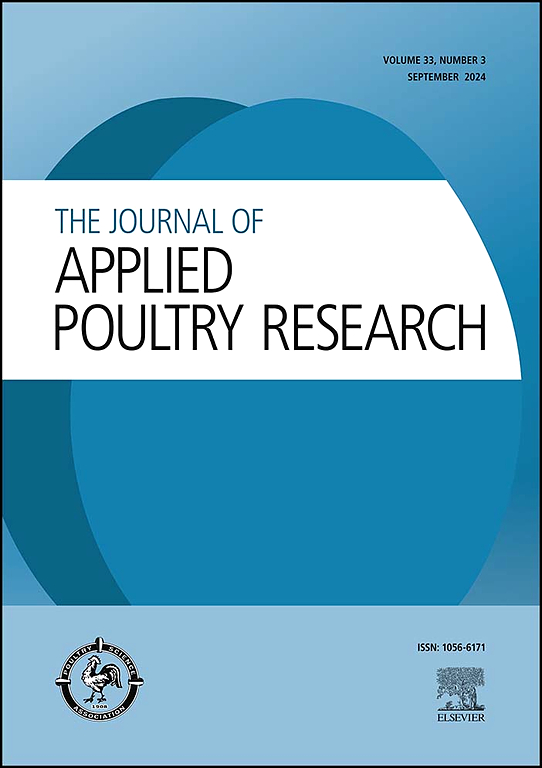Applied research note: Understanding varying levels of hydrogen peroxide residuals in poultry drinking water in early broiler growth performance
IF 2
3区 农林科学
Q2 AGRICULTURE, DAIRY & ANIMAL SCIENCE
引用次数: 0
Abstract
Hydrogen peroxide (H₂O₂) based products are used to sanitize poultry drinking water supplies; however, the effects of their higher residual levels on broiler performance remain unstudied. This study investigated the effects of different residual peroxide concentrations in drinking water on early broiler growth and amino acid (AA) digestibility. A total of 100 Cobb 500 male chicks reared on a corn–soy starter diet from d 0 to 13 were assigned to 5 treatment groups. Four stock solutions were prepared by mixing the H₂O₂ product with water at the following ratios: T1 (2:32), T2 (4:32), T3 (8:32), and T4 (16:32); and 1 mL of each stock solution was diluted with 100 mL of drinking water to create the drinking water treatments. The initial H₂O₂ residual concentrations in drinking water were approximately 17.6 ppm for T1, 33.3 ppm for T2, 60 ppm for T3, and 100 ppm for T4. After 24 h, the residuals dropped to approximately <10 ppm in T1, <30 ppm in T2, <50 ppm in T3, and remained ≤90 ppm in T4. Municipal water free of H2O2 and Cl served as the control (CON). Growth performances, AA digestibility, and water intake (WI) were recorded for treatment groups. The treated groups (T2 & T4) showed a higher body weight gain (BWG) and a lower FCR compared to the CON (P < 0.05). Additionally, the digestibility of essential (isoleucine, leucine, lysine, phenylalanine, threonine, tryptophan, valine) and non-essential (alanine, aspartic acid, cysteine, glutamic acid, glycine, proline, tyrosine) amino acids improved with these treatments. Results showed that all the tested levels of H₂O₂ residuals in drinking water (up to 100 ppm) can be safely used for sanitizing poultry drinking water supplies without compromising amino acid digestibility or early bird performance.
应用研究说明:了解家禽饮用水中过氧化氢残留量的变化对肉鸡早期生长性能的影响
过氧化氢(H₂O₂)产品用于消毒家禽饮用水供应;然而,其高残留水平对肉鸡生产性能的影响尚未研究。本试验旨在研究饮用水中不同过氧化氢残留量对肉鸡早期生长和氨基酸消化率的影响。选取100只饲喂0 ~ 13 d玉米-大豆起始日粮的Cobb 500雄性雏鸡,分为5个处理组。将H₂O₂产品与水按以下比例混合制备四种原液:T1 (2:32), T2 (4:32), T3 (8:32), T4 (16:32);每种原液用100毫升饮用水稀释1毫升,形成饮用水处理。饮用水中最初的h2o2残留浓度分别为:T1 17.6 ppm、T2 33.3 ppm、T3 60 ppm、T4 100 ppm。24 h后,残余量在T1降至约10ppm,在T2降至30ppm,在T3降至50ppm,在T4降至≤90ppm。不含H2O2和Cl的城市水作为对照(CON)。记录各处理组生长性能、AA消化率和摄水量(WI)。治疗组(T2 &;与对照组相比,T4组的体重增加(BWG)较高,FCR较低(P <;0.05)。此外,必需氨基酸(异亮氨酸、亮氨酸、赖氨酸、苯丙氨酸、苏氨酸、色氨酸、缬氨酸)和非必需氨基酸(丙氨酸、天冬氨酸、半胱氨酸、谷氨酸、甘氨酸、脯氨酸、酪氨酸)的消化率也通过这些处理得到改善。结果表明,饮用水中所有的H₂O₂残留量(高达100 ppm)都可以安全地用于家禽饮用水的消毒,而不会影响氨基酸消化率或早期鸟类的生产性能。
本文章由计算机程序翻译,如有差异,请以英文原文为准。
求助全文
约1分钟内获得全文
求助全文
来源期刊

Journal of Applied Poultry Research
农林科学-奶制品与动物科学
CiteScore
4.10
自引率
10.50%
发文量
80
审稿时长
104 days
期刊介绍:
The Journal of Applied Poultry Research (JAPR) publishes original research reports, field reports, and reviews on breeding, hatching, health and disease, layer management, meat bird processing and products, meat bird management, microbiology, food safety, nutrition, environment, sanitation, welfare, and economics. As of January 2020, JAPR will become an Open Access journal with no subscription charges, meaning authors who publish here can make their research immediately, permanently, and freely accessible worldwide while retaining copyright to their work. Papers submitted for publication after October 1, 2019 will be published as Open Access papers.
The readers of JAPR are in education, extension, industry, and government, including research, teaching, administration, veterinary medicine, management, production, quality assurance, product development, and technical services. Nutritionists, breeder flock supervisors, production managers, microbiologists, laboratory personnel, food safety and sanitation managers, poultry processing managers, feed manufacturers, and egg producers use JAPR to keep up with current applied poultry research.
 求助内容:
求助内容: 应助结果提醒方式:
应助结果提醒方式:


